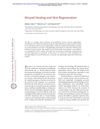Label-Free Concurrent 5-Modal Microscopy (Co5M) Resolves Unknown Spatio-Temporal Processes in Wound Healing
September 2021
in “
Communications Biology
”
TLDR Co5M offers a new way to observe and understand wound healing without labels.
The study introduced concurrent 5-modal microscopy (Co5M) as a novel, label-free method for in vivo observation of biological processes, specifically focusing on wound healing. Co5M combined optoacoustic, two-photon excitation fluorescence, second and third harmonic generation, and brightfield contrast to non-invasively visualize and quantitatively monitor various wound healing biomarkers. This approach allowed for the analysis of longitudinal changes in wound shape, microvascular and collagen density, vessel size and fractality, and sebaceous gland plasticity. The insights gained from Co5M provided a deeper understanding of the spatial and temporal dynamics of wound closure, vasodilation, angiogenesis, skin contracture, and epithelial reformation, which were not accessible through traditional methods.







